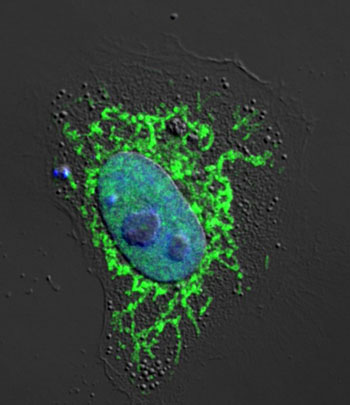A Host Protein Interferes with the Immune System's Ability to Deal with DNA Viruses
By LabMedica International staff writers
Posted on 27 Apr 2016
A team of molecular immunologists has identified a human protein that interferes with the ability of the immune system to ward off infections caused by viruses such as HIV.Posted on 27 Apr 2016
Investigators at the Sanford Burnham Prebys Medical Discovery Institute (La Jolla, CA, USA) and their colleagues at the University of North Carolina (Chapel Hill, USA) focused their attention on NLRX1 (nucleotide-binding oligomerization domain, leucine rich repeat containing X1), an NLR protein that earlier had been identified in an unbiased siRNA (short interfering RNA) screen as being required for HIV infection.

Image: A confocal fluorescence microscopy image of NLRX1 (green) in a HeLa cell (blue, nuclear stain) (Photo courtesy of Dr. Haitao Guo, University of North Carolina).
The investigators reported in the April 13, 2016, issue of the journal Cell Host & Microbe that depletion of NLRX1 impaired the ability of HIV to infect cells by blocking nuclear import of HIV-1 DNA into human monocytic cells. Although HIV is a single-stranded RNA virus, reverse transcriptase enzymes in immune cells rapidly convert the viral genetic package into DNA, increasing the level of DNA found in the cytosol.
When NLRX1 was present, it was observed to reduce production of type-I interferon (IFN-I) and immune system stimulating cytokines in response to HIV-1 reverse-transcribed DNA. In addition, NLRX1 sequestered the DNA-sensing adaptor STING (stimulator of interferon genes) and prevented it from interacting with the enzyme TANK-binding kinase 1 (TBK1), which is required for IFN-1 induction in response to DNA.
Mice that had been genetically engineered to lack the gene for producing NLRX1 exhibited enhanced innate immunity and reduced viral load when infected with DNA viruses. Thus, NLRX1 acted as a negative regulator of the host innate immune response to HIV-1 and DNA viruses.
“Our study provides critical insight on a paramount issue in HIV research: Why is the body unable to mount an efficient immune response to HIV to prevent transmission?” said contributing author Dr. Sumit Chanda, professor of immunology at the Sanford Burnham Prebys Medical Discovery Institute. “This research shows that the host protein NLRX1 is responsible - it is required for HIV infection and works by repressing the innate immune response. Importantly, we were able to show that deficiencies in NLRX1 reduce HIV replication, suggesting that the development of small molecules to modulate the innate immune response may inhibit viral transmission and promote immunity to infection. We anticipate expanding our research to identify NLRX1 inhibitors.”
“Our discovery that NLRX1 reduces the immune response to HIV is similar to the discovery of host immune checkpoints, such as PD-L1 and CTLA-1, that control the immune response to cancer,” said senior author Dr. Jenny Ting, professor of microbiology and immunology at the University of North Carolina. “Checkpoint inhibitors have made a huge impact on cancer treatment, and significant investment by the biotech/pharmaceutical sector is being made to identify STING inhibitors as the next generation of immune-oncology therapeutics. This study, showing that NLRX1 is a checkpoint of STING, sheds more light on the topic and will help advance those efforts.”
Related Links:
Sanford Burnham Prebys Medical Discovery Institute
University of North Carolina














